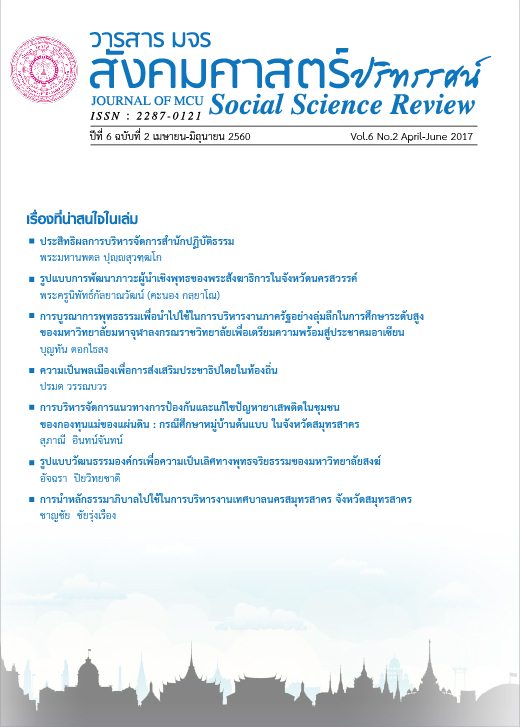ภูมิปัญญาพื้นบ้านในการป้องกันโรคไข้เลือดออกโดยเครือข่ายชุมชน ภาคอีสาน
คำสำคัญ:
แอพลิเคชัน บูรณาการ การป้องกันโรคไข้เลือดออก ภูมิปัญญาท้องถิ่นบทคัดย่อ
การศึกษาเรื่อง “การประยุกต์ภูมิปัญญาพื้นบ้านในการป้องกันโรคไข้เลือดออกโดย เครือข่ายชุมชนภาคอีสาน” ครั้งนี้เป็นการวิจัยเชิงคุณภาพ มีความมุ่งหมายในการวิจัย คือ 1) เพื่อ ศึกษาความเป็นมาของการใช้ภูมิปัญญาพื้นบ้านในการป้องกันโรคไข้เลือดออกโดยเครือข่ายชุมชน ภาคอีสาน 2) เพื่อศึกษาสภาพปัจจุบันและปัญหาการใช้ภูมิปัญญาพื้นบ้านในการป้องกันโรค ไข้เลือดออกโดยเครือข่ายชุมชน ภาคอีสาน 3) เพื่อศึกษาการประยุกต์ภูมิปัญญาพื้นบ้านในการ ป้องกันโรคไข้เลือดออกโดยเครือข่ายชุมชน ภาคอีสานผู้วิจัยได้คัดเลือกพื้นที่ทาการวิจัยแบบเจาะจง ประกอบด้วยพื้นที่ 3 จังหวัดได้แก่ จังหวัดสุรินทร์ จังหวัดชัยภูมิและจังหวัดมุกดาหาร ประชากร กลุ่มตัวอย่างจากภาครัฐและเอกชนจานวน 111 คน เครื่องมือที่ใช้ในการวิจัยได้แก่แบบสารวจ การ สังเกตแบบมีส่วนร่วมและไม่มีส่วนร่วม การสัมภาษณ์แบบมีโครงสร้างและไม่มีโครงสร้าง การ สนทนากลุ่ม และการประชุมเชิงปฏิบัติการ
ผลการวิจัยพบว่า
การจัดสิ่งแวดล้อมให้สะอาดน่าอยู่ไม่เป็นแหล่งเพาะพันธุ์ยุงลาย ยังปลูกพืชสมุนไพรต้น ตระไคร้หอมไล่ยุงและทาน้ามันตระไคร้หอมหยดใส่เสื้อผ้าและถังน้าให้ยุงลายเหม็นกลิ่นและบินหนี ไป นอกจากนี้ยังใช้กระบอกพ่นน้าไล่ยุงให้ยุงเปียกบินไม่ได้และหนีไป ใส่ผลมะกรูดลงในภาชนะเก็บ น้าในห้องสุขา และอ่างล้างเท้าเพื่อกันยุงลายวางไข่ใส่ปลากินลูกน้าเพื่อป้องกันการขยายตัวของ ยุงลายปิดฝาภาชนะด้วยตาข่ายไนลอนแล้วปิดทับด้วยฝาสังกะสีแล้วทาก๊อกน้าปิดเปิดด้านล่าง หรือ ปิดฝาภาชนะทิ้งไว้นานเกิน 2 เดือน กาจัดขยะให้ถูกวิธี ปัญหาทั่วไปที่พบยังพบอย่างต่อเนื่องคือที่ วัดไม่ได้ปฏิบัติเนื่องจากไม่อยากฆ่าสัตว์ ผลมะกรูดที่ใส่ไว้ก็ไม่ได้รับการดูแลเท่าที่ควรปล่อยให้เน่า เปื่อย ห้องน้าสกปรกมีกลิ่นเหม็นจึงเป็นแหล่งเพาะพันธุ์ยุงลายได้ง่าย นอกจากนี้ยังมีสภาพแวดล้อม ที่ไม่สะอาดบางแห่งสกปรกมากเป็นแหล่งขยายพันธุ์ยุงมากหรือแม้กระทั่งผู้ป่วยโรคไข้เลือดออกนึก ว่าตัวเองหายป่วยแล้วจึงไม่ระมัดระวังตัวในการป้องกันยุงลายกัด การปิดฝาโอ่งน้ายังพบว่าปิดไม่ สนิทเช่นกัน จึงไม่สามารถกาจัดยุงลายได้อย่างมีประสิทธิภาพเป็นโอกาสที่จะถูกยุงลายกัดได้ นอกจากนี้ยังต้องใช้วิธีการที่ได้รับความรู้ความเข้าใจจากเครือข่ายชุมชน ไม่ว่าจะเป็น อาสาสมัคร สาธารณสุขประจาหมู่บ้าน (อสม.) องค์การบริหารส่วนตาบล (อบต.) เจ้าหน้าที่ของรัฐและองค์กร เอกชนในการร่วมมือกันในการเฝ้าระวังและป้องกันยุงลาย และการใช้ภูมิปัญญาพื้นบ้าน เช่นการใช้ น้ามันจากต้นตระไคร้หอมหยดในน้าหรือบริเวณบ้านและปลูกต้นไม้ไล่ยุง ผสมผสานกับเทคโนโลยี ร่วมสมัยเพื่อให้ทันต่อความเจริญอย่างรวดเร็วของสังคมที่มีการพัฒนาไม่หยุดยั้งและให้เข้ากับยุค สมัยของบริบทพื้นที่ซึ่งเป็นวัฒนธรรมท้องถิ่นที่มีค่าควรหวงแหน
เอกสารอ้างอิง
Kamolporn Kalyanamitra. (2560). Sufficiency Economy : A Guiding Light Towards Sustainable Development In Bansapanpak Community. MCU Journal of Social Sciences, 6(1), 197-208.
Passakorn Sanguearnchart. (2552). Community Participation in Dengue Prevention
Pratoomtip Hormklin. (2551). Measurement and Control of Dengue by Health Volunteers at Yangtalad Sub-District Munucipality. Yangtalad District. Kalasin Province (Master of Public Administration Thesis) Khonkaen: Khonkaen Univerwity.
Somsak Sripakdee. (2554). Relations between Climate Change and Dengue Epidemics (Doctor of Philosophy Thesis). Mahasarakam: Mahasarakam University.
Songkun Chantajorn. (2553). Theory of Culture and Society. Mahasarakam: Mahasarakam University.
Sontaya Polsri. (2500). Community Development Learning Network. 2nd edition. Bangkok: Odien Store Ta-uten District. Nakornpanom Province (Master of Education Thesis). Mahasarakam: Mahasarakam Univesity.
ดาวน์โหลด
เผยแพร่แล้ว
รูปแบบการอ้างอิง
ฉบับ
ประเภทบทความ
สัญญาอนุญาต
ลิขสิทธิ์ (c) 2018 วารสาร มจร สังคมศาสตร์ปริทรรศน์

อนุญาตภายใต้เงื่อนไข Creative Commons Attribution-NonCommercial-NoDerivatives 4.0 International License.
เพื่อให้เป็นไปตามกฎหมายลิขสิทธิ์ ผู้นิพนธ์ทุกท่านต้องลงลายมือชื่อในแบบฟอร์มใบมอบลิขสิทธิ์บทความให้แก่วารสารฯ พร้อมกับบทความต้นฉบับที่ได้แก้ไขครั้งสุดท้าย นอกจากนี้ ผู้นิพนธ์ทุกท่านต้องยืนยันว่าบทความต้นฉบับที่ส่งมาตีพิมพ์นั้น ได้ส่งมาตีพิมพ์เฉพาะในวารสาร มจร สังคมศาสตร์ปริทรรศน์ เพียงแห่งเดียวเท่านั้น หากมีการใช้ภาพหรือตารางหรือเนื้อหาอื่นๆ ของผู้นิพนธ์อื่นที่ปรากฏในสิ่งตีพิมพ์อื่นมาแล้ว ผู้นิพนธ์ต้องขออนุญาตเจ้าของลิขสิทธิ์ก่อน พร้อมทั้งแสดงหนังสือที่ได้รับการยินยอมต่อบรรณาธิการ ก่อนที่บทความจะได้รับการตีพิมพ์ หากไม่เป็นไปตามข้อกำหนดเบื้องต้น ทางวารสารจะถอดบทความของท่านออกโดยไม่มีข้อยกเว้นใดๆ ทั้งสิ้น





